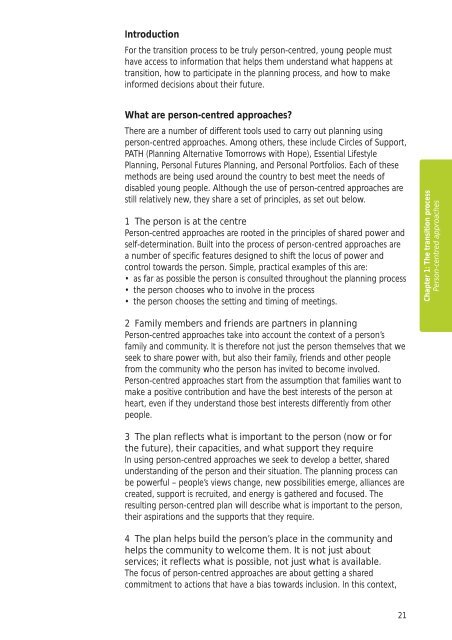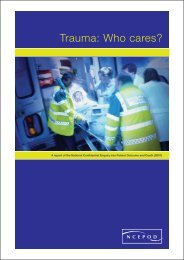A Transition Guide for All Services - Transition Information Network
A Transition Guide for All Services - Transition Information Network
A Transition Guide for All Services - Transition Information Network
- No tags were found...
Create successful ePaper yourself
Turn your PDF publications into a flip-book with our unique Google optimized e-Paper software.
IntroductionFor the transition process to be truly person-centred, young people musthave access to in<strong>for</strong>mation that helps them understand what happens attransition, how to participate in the planning process, and how to makein<strong>for</strong>med decisions about their future.What are person-centred approaches?There are a number of different tools used to carry out planning usingperson-centred approaches. Among others, these include Circles of Support,PATH (Planning Alternative Tomorrows with Hope), Essential LifestylePlanning, Personal Futures Planning, and Personal Portfolios. Each of thesemethods are being used around the country to best meet the needs ofdisabled young people. Although the use of person-centred approaches arestill relatively new, they share a set of principles, as set out below.1 The person is at the centrePerson-centred approaches are rooted in the principles of shared power andself-determination. Built into the process of person-centred approaches area number of specific features designed to shift the locus of power andcontrol towards the person. Simple, practical examples of this are:• as far as possible the person is consulted throughout the planning process• the person chooses who to involve in the process• the person chooses the setting and timing of meetings.Chapter 1: The transition processPerson-centred approaches2 Family members and friends are partners in planningPerson-centred approaches take into account the context of a person’sfamily and community. It is there<strong>for</strong>e not just the person themselves that weseek to share power with, but also their family, friends and other peoplefrom the community who the person has invited to become involved.Person-centred approaches start from the assumption that families want tomake a positive contribution and have the best interests of the person atheart, even if they understand those best interests differently from otherpeople.3 The plan reflects what is important to the person (now or <strong>for</strong>the future), their capacities, and what support they requireIn using person-centred approaches we seek to develop a better, sharedunderstanding of the person and their situation. The planning process canbe powerful – people’s views change, new possibilities emerge, alliances arecreated, support is recruited, and energy is gathered and focused. Theresulting person-centred plan will describe what is important to the person,their aspirations and the supports that they require.4 The plan helps build the person’s place in the community andhelps the community to welcome them. It is not just aboutservices; it reflects what is possible, not just what is available.The focus of person-centred approaches are about getting a sharedcommitment to actions that have a bias towards inclusion. In this context,21
















